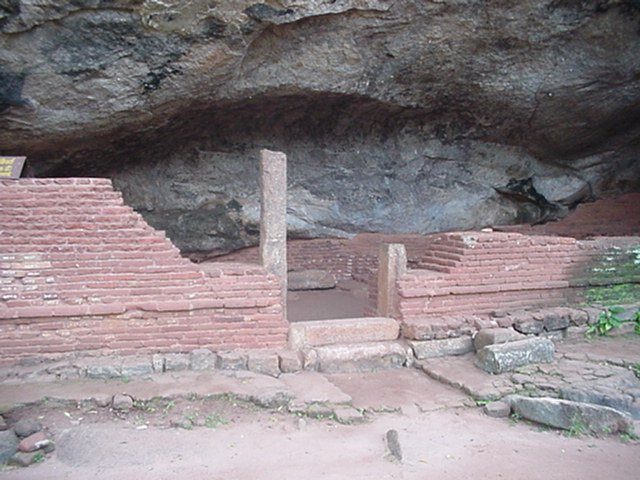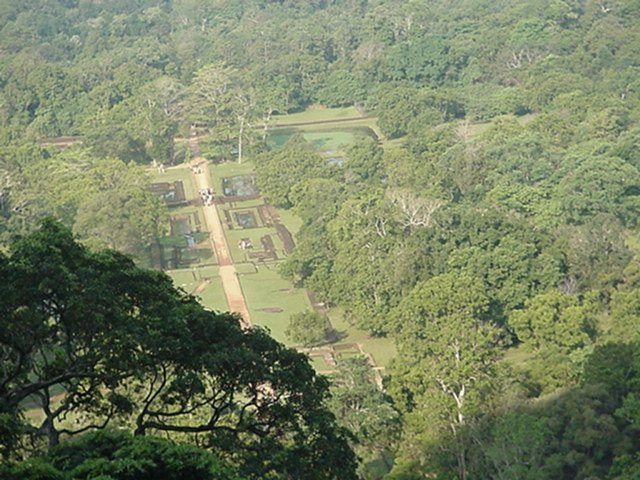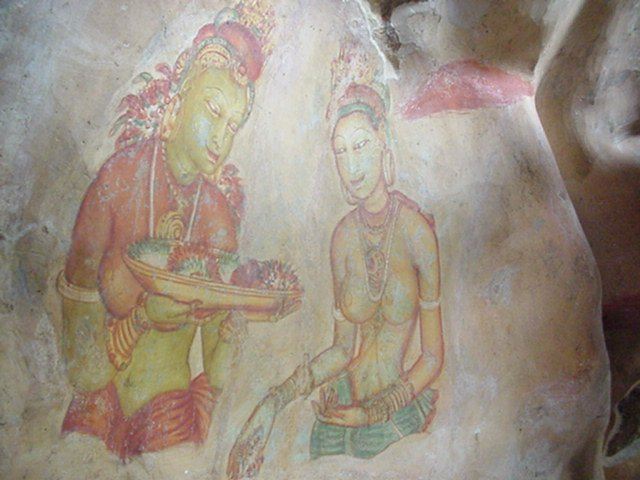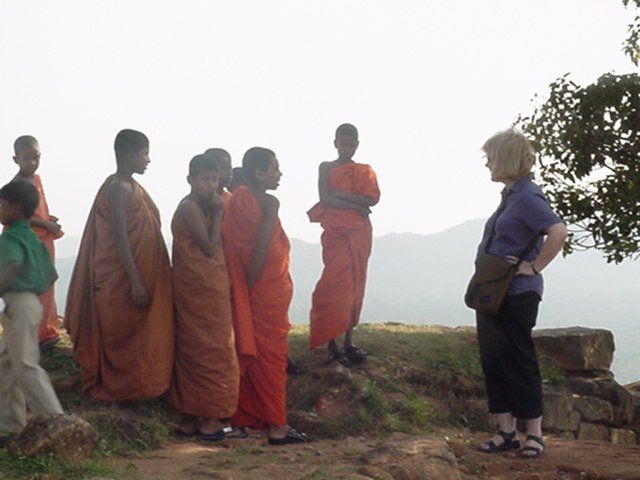A Short History of Sigirya
[Click arrow at bottom to proceed to Architectural Design]
History: A Tale of Three Cities
 Sigirya's legacy stretches back into prehistory; it boasted human
settlements as early as the Mesolithic period, and can claim continuous occupation for
a period of over five thousand years. The rock
outcroppings at the base of the huge rock formed caves in which people lived.
These caves became monastic cells during the fifth century B.C. with the
establishment of a Buddhist settlement on the rock-strewn western and
northern slopes of the hills surrounding the rock. Sigiriya grew from a
series of rock shelters into an urban center in the 5th century A.D., during the reign of
King Kasyapa, the man who transformed the mountain into a spectacular kingdom.
There seem to be three distinct theories about Kasyapa's life, his aspirations,
and his role in the development of the Sigiriya complex.
Sigirya's legacy stretches back into prehistory; it boasted human
settlements as early as the Mesolithic period, and can claim continuous occupation for
a period of over five thousand years. The rock
outcroppings at the base of the huge rock formed caves in which people lived.
These caves became monastic cells during the fifth century B.C. with the
establishment of a Buddhist settlement on the rock-strewn western and
northern slopes of the hills surrounding the rock. Sigiriya grew from a
series of rock shelters into an urban center in the 5th century A.D., during the reign of
King Kasyapa, the man who transformed the mountain into a spectacular kingdom.
There seem to be three distinct theories about Kasyapa's life, his aspirations,
and his role in the development of the Sigiriya complex.
KASYAPA, THE EVIL SON: A MORALITY TALE
 The most-oft told story paints Kasyapa as a parricidal monster.
Kasyapa, the
son of the king by a consort, killed his father, Dhatusena I (459-477), by
imprisoning him and entombing him behind a wall while he was still alive in
order to gain the throne. Driven into exile, his half-brother, the crown prince Moggallana, retreated
to India and assembled an army to avenge his father's death. Kasyapa prepared
for this eventuality by transforming the Sigiriya into a impenetrable complex.
It was all for naught for, according to the legend, Kasyapa was lured
from the rock by Moggallana. Enroute to do battle Kasyapa's elephant changed
direction, sensing a swamp; his followers interpreted this as a retreat, and
Kasyapa found himself alone in the face of an advancing army. Rather than facing
death at the hands of his half-brother he beheaded himself, bringing this
morality tale to its fitting conclusion.
Click here to learn more about
this view
The most-oft told story paints Kasyapa as a parricidal monster.
Kasyapa, the
son of the king by a consort, killed his father, Dhatusena I (459-477), by
imprisoning him and entombing him behind a wall while he was still alive in
order to gain the throne. Driven into exile, his half-brother, the crown prince Moggallana, retreated
to India and assembled an army to avenge his father's death. Kasyapa prepared
for this eventuality by transforming the Sigiriya into a impenetrable complex.
It was all for naught for, according to the legend, Kasyapa was lured
from the rock by Moggallana. Enroute to do battle Kasyapa's elephant changed
direction, sensing a swamp; his followers interpreted this as a retreat, and
Kasyapa found himself alone in the face of an advancing army. Rather than facing
death at the hands of his half-brother he beheaded himself, bringing this
morality tale to its fitting conclusion.
Click here to learn more about
this view
KASYAPA: REALIZING THE DREAMS OF DHATUSENA I
 However more recently other theories have been advanced. One
disputes Kasyapa's patricide, arguing that he inadvertently killed his
father in battle, deceived by his half-brother. This version paints Kasyapa in an entirely different light; he is
viewed as a brilliant designer and devoted son. According to this view, his
decision to abandon his father's capital at Anuradhapura arose from the desire
to complete his father's dream, to build a heavenly palace on the order of the
mythical Tibetan palace of the god of wealth, Kuvera. In so doing Kasyapa would assume the highest mantle of power
to which a
secular leader at that time could aspire; Sigiriya is in essence a completion
of his father's dream, and Kasyapa is seen as a faithful son.
Click here to learn more
However more recently other theories have been advanced. One
disputes Kasyapa's patricide, arguing that he inadvertently killed his
father in battle, deceived by his half-brother. This version paints Kasyapa in an entirely different light; he is
viewed as a brilliant designer and devoted son. According to this view, his
decision to abandon his father's capital at Anuradhapura arose from the desire
to complete his father's dream, to build a heavenly palace on the order of the
mythical Tibetan palace of the god of wealth, Kuvera. In so doing Kasyapa would assume the highest mantle of power
to which a
secular leader at that time could aspire; Sigiriya is in essence a completion
of his father's dream, and Kasyapa is seen as a faithful son.
Click here to learn more
SIGIRIYA: THE BUDDHIST CREATION
 Still another version casts doubt on both theories. First, it
maintains that it is unlikely that Sigiriya was built as a fortress, for it
could be starved out by a siege in less than six months. And it also challenges
the the heavenly palace theory, arguing that given the weather
conditions and the relative brevity of Kasyapa's tenure at Sigiriya, it is most
likely the grand design was executed over a much longer period of time. This
view maintains the development of Sigiriya was accomplished by and large by the
monks who occupied the mountain before and after Kasyapa, the gradual evolution
of a religious and aesthetic vision. Click here to learn more about this view.
Click here to learn more
Still another version casts doubt on both theories. First, it
maintains that it is unlikely that Sigiriya was built as a fortress, for it
could be starved out by a siege in less than six months. And it also challenges
the the heavenly palace theory, arguing that given the weather
conditions and the relative brevity of Kasyapa's tenure at Sigiriya, it is most
likely the grand design was executed over a much longer period of time. This
view maintains the development of Sigiriya was accomplished by and large by the
monks who occupied the mountain before and after Kasyapa, the gradual evolution
of a religious and aesthetic vision. Click here to learn more about this view.
Click here to learn more
While we may never know the true story of Kasyapa and his
contributions to Sigiriya, it is clear that by the time of his death in 495
A.D., most of the architectural details which make Sigiriya a wonder of the
ancient world were in place. Let us now turn our attention to those details.
On to Architectural Design

Return to Sigiriya Main Page
 Sigirya's legacy stretches back into prehistory; it boasted human
settlements as early as the Mesolithic period, and can claim continuous occupation for
a period of over five thousand years. The rock
outcroppings at the base of the huge rock formed caves in which people lived.
These caves became monastic cells during the fifth century B.C. with the
establishment of a Buddhist settlement on the rock-strewn western and
northern slopes of the hills surrounding the rock. Sigiriya grew from a
series of rock shelters into an urban center in the 5th century A.D., during the reign of
King Kasyapa, the man who transformed the mountain into a spectacular kingdom.
There seem to be three distinct theories about Kasyapa's life, his aspirations,
and his role in the development of the Sigiriya complex.
Sigirya's legacy stretches back into prehistory; it boasted human
settlements as early as the Mesolithic period, and can claim continuous occupation for
a period of over five thousand years. The rock
outcroppings at the base of the huge rock formed caves in which people lived.
These caves became monastic cells during the fifth century B.C. with the
establishment of a Buddhist settlement on the rock-strewn western and
northern slopes of the hills surrounding the rock. Sigiriya grew from a
series of rock shelters into an urban center in the 5th century A.D., during the reign of
King Kasyapa, the man who transformed the mountain into a spectacular kingdom.
There seem to be three distinct theories about Kasyapa's life, his aspirations,
and his role in the development of the Sigiriya complex.


